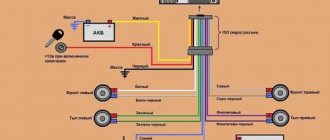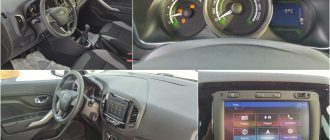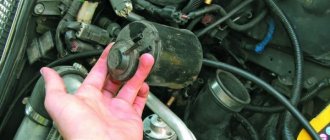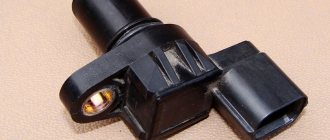A car battery case that functions as a thermal case will help protect not only from dirt and precipitation. But also from the influence of temperature conditions and resolve the issue in frosty conditions. When the temperature drops to -25 degrees, the problem of starting the engine becomes most pressing.
Some buy this device from dealers, while others make it themselves.
Thermal case concept
Until recently, no one could even think that it was possible to have a personal “coat” for a battery. Moreover, it was difficult to obtain suitable materials for the case.
However, scientific and technological progress is rapidly moving forward. And the emergence of new heat-resistant and comfortable bases for such a design has led to widespread adoption of this convenient idea.
The ability of a battery to recharge after standing in frosty conditions overnight is 10%. Therefore, it makes sense to prevent it from completely freezing. Whether your battery will cool down depends on the quality of the thermal case.
Do you need a battery case in your car?
This device is optional, that is, it is not included in the required set of devices for the car. Each driver makes the decision to purchase it independently.
A number of different factors will influence this. Much depends on what climate zone you live in and under what conditions you operate your car.
Thermal case can protect the battery from dust, dirt and chemical effects of liquids on difficult routes. It will also prevent mechanical damage, but it will not protect the wires and heating elements.
Battery protection from frost
In winter, the battery can hardly provide high current to the starter. Even if you use high-quality oil, it is not so easy to start the engine in severe frost.
Constantly removing the battery and carrying it home is not an option. This is not convenient and the car remains without an alarm system, which also gets on your nerves.
Experienced car enthusiasts recommend using an insulated battery case in such cases. Especially if you live in cold regions.
Battery overheat protection
The case in which the battery is hidden can protect the battery not only from extreme cold. But also from excessive heat, that is, in the case of a battery from overheating.
Being under the hood, one side of the battery, directed towards the engine, heats up more than the others. As a result, heated banks receive a strong charge, and unheated ones remain uncharged.
Thus, drivers independently try to make such covers to balance these temperatures. Not everyone is positive, so it’s easier to use the factory options.
Preparation
- Stock up on containers for draining used electrolyte and diluting new one;
- Before work, check the plastic for resistance to electrolyte.
To increase the electrolyte density you need:
- container with measuring marks;
- hydrometer;
- soldering iron;
- electrolyte;
- enema pear;
- battery water;
- drill;
- distilled water.
We measure the density in each jar. If it is 1.25–1.28, and the spread is no more than 0.01, then the battery is normal and can be used. If the readings fluctuate at 1.18–1.20, then you need to add an electrolyte with a density of 1.27.
- Using an enema, pump out the largest possible volume of old electrolyte from the jar and measure it;
- Fill in a new solution at the rate of half of the pumped out;
- Gently rock the battery to mix the liquids;
- Measure the density - if the value is insufficient, you need to add more electrolyte;
- Fill the remainder with distilled water.
Protection from external damage and dirt
If you operate the vehicle at average temperatures. And you are not worried about the issue of hypothermia or overheating of the battery. You can use battery protection from dust, dirt and external damage.
In this case, the option of a self-sewn bag is quite suitable. Moreover, when protecting from dust and dirt, heating plates are not needed. In this case, the design is supposed to be quite simple.
Assembling the heating element
To ensure proper heating of the battery, we need to take a long, preferably metal plate and attach our wire to it. The plate should be taken from aluminum or copper (they have a higher thermal energy output), but to save money, you can also use metal. Let's say part of the profile for GVL.
I had an aluminum strip lying around (I bought it a long time ago to experiment with computer cooling) and I will use it. The thickness is 2 mm, its width is 5 cm, but what is the length?
I decided to make the length approximately 22 cm, because we have 0.5 meter sections for heating, if we make a loop it will be 25 cm, it also leaves ends for connecting wires.
I decided to cut off two pieces . By why? Yes, simply because I don’t want the cable to come into contact with the surface of the battery or thermal case. There will be a piece on top, below, and a cable between them.
The question arose - how to attach these two sections to the cable. So that it is tight and so that there is heat exchange?
At first I thought of filling everything with high-temperature sealant, but as far as I know it turns into hard silicone, similar to rubber (maybe I’m wrong). And rubber does not conduct heat well.
A friend had a cold welding machine lying around in his garage when he bought it, but it never came in handy. I decided to connect the plates and cable to it. As usual, it is mixed like plasticine, until the composition is homogeneous and then applied.
I stirred it, applied it to the plate on which the cable lay in a loop, then attached a second loop and covered everything with the top strip of aluminum. Then I used the remaining “welding” to process the edges and corners so that there was a monolithic structure.
I left everything for a day, the welding turned to stone.
Types of battery cases
Currently, many manufacturers are offering their own solutions to the problem of battery cooling.
There are different models on the market that are suitable not only for domestic and European cars. But also for Asian, non-standard battery shapes.
There are fundamentally two different groups of battery thermal cases:
- Without a heating function (just a box) it is called “wrong”.
- With a heating function (the design accommodates heating elements) - “correct”.
In turn, there is an option with a heating function, where the insulation design includes special heating plates:
- consuming battery energy;
- do not consume battery energy.
Let's take a closer look at each type separately.
Incorrect thermal case
A warm battery always turns the car engine better and charges faster. For example, you start your car at minus 25 degrees and start driving. You reach your destination in 20 minutes.
The battery does not have time to warm up, and the current that the battery supplied to start the car is not fully replenished. The same thing can happen several times a day. Thus, you end up with constant undercharges.
In order for the battery to be fully recharged, you need to drive for 30-40 minutes. So that the engine compartment warms up and the battery becomes warm. Only then will the battery begin to take charge.
In cases where we install a warm battery in a thermal box, then the case will retain the heat. But if the battery is cold (after a night of inactivity) and it is enclosed in a thermal case, the engine compartment will heat up when the car is started.
So the battery is inside a thermal box, like in a refrigerator, which does not allow it to warm up. In this case, the battery without the thermal case would have already warmed up. But our battery in a “fur coat” cannot do this, since the case itself does not allow heat to pass through.
It is for this reason that it is not recommended to purchase a thermal case without heating elements and it is considered “incorrect”.
The right thermal case
Be sure to include heating plates that heat the battery inside the case.
There are two types:
- The most common one is that the plates heat up after the engine is turned on and do not consume battery energy.
- The plates keep the battery warm when the machine is idle and are powered by the battery.
The plate design contains an electrical relay that senses the voltage in the on-board network. When the voltage is above 13.8, only then the relay turns on the plates, which begin to heat up.
In this case, the battery heats up and charges very quickly. Replenishes its reserves of electricity that were spent on a cold start. Accordingly, only the design of a thermal case with heating plates makes sense.
Thermal covers that do not consume battery energy
Heating plates are placed on the sides of this battery case, and in some cases can be installed under the battery itself. Their wires are routed to the battery terminals. In this case, the battery should be compact in the case, only the information display with LEDs comes out. The display shows the battery charging level and the activity of the heating plates.
The battery case itself in this case performs low-performance functions. It does not heat the battery, but only retains the heat generated by the plates. This heat can keep the battery warm during cold parking.
The advantages of such thermal cases are that they do not take energy from the battery when parked. This means they don’t “jail” him.
Thermal cases that consume battery energy
This is another type of case that can heat the battery while parked. When the temperature drops below the set temperature, the thermostat of such a case turns on and takes energy from the battery. At the same time, it heats up and warms up the battery with its heat.
When the temperature reaches certain limits, such heating elements turn off. Thereby regulating a constant warm temperature around the battery.
The advantage of this type of thermal cases is that you will not have problems starting the engine, since the battery will be constantly warm.
The disadvantage is that such a system discharges the battery, which can then only be recharged while the car is moving.
Heating elements
If you purchase a heated thermal case, then you will definitely be offered a system with heating elements for it. You won't need to purchase it yourself.
The plates are made of special plastic or other material. Which has heating elements built into it. The standard kit includes two such plates, placed on the largest sides of the battery.
They consume energy in small quantities from 15 to 40 W. This temperature is comfortable for the battery and can keep it warm.
There are car owners who take small batteries from home with them to warm up the main one, but this is not a very convenient option.
Rating of the best insulation materials
Making your own battery charge indicator controller
First of all, we will discuss insulation for the engine, since they are more popular products than their counterparts for the radiator and battery. In accordance with reviews of car enthusiasts on the Internet, currently the most common brands under which the mentioned products are produced are TORSO, STP HEATSHIELD, SKYWAY, “Avto-MAT” and “Avtoteplo”. They will be discussed further.
Car blanket TORSO
A distinctive feature of the TORSO car blanket is its low price. For example, a product measuring 130 by 80 cm as of the beginning of 2022 costs about 500 rubles. However, a significant drawback of this product is the lack of official certification. Car blankets are available in different sizes, so they can be used on small cars, crossovers and SUVs. The warranty period for this car blanket is 3 years. The weight of a product measuring 130 by 80 cm is 1 kg. Article number - 1228161.
Insulation STP Heat Shield
Engine insulation StP HeatShield
The STP Heat Shield car blanket is also available in different sizes for both passenger cars and SUVs. For example, there are sizes 600 by 1350 mm, 800 by 1350 mm and others. A distinctive feature of these products is the presence of not only heat, but also sound insulation. Also in the summer, protection can be used between the engine and the passenger compartment, which reduces the noise load in the car interior. The blanket consists of the following materials:
- non-woven fabric resistant to oil, fuel and other process fluids;
- noise and heat-absorbing layer;
- an adhesive layer that is resistant to high temperature changes and serves as the mechanical basis of the insulation.
The product is secured using the 8 clips included. With their help you can attach a blanket in the summer. In winter, it can be laid directly on the engine housing. The cost of both of these models is approximately the same and is about 1000 rubles.
Car blanket Skyway
This brand produces 11 models with different dimensions. The peculiarity of the products is the excellent price-quality ratio. According to reviews from many car owners, the blanket works for about 2.3 years without loss of performance characteristics
The disadvantages include the easy possibility of damage to the surface of the product, which is why it is necessary to install the insulation carefully so as not to damage it. Despite the differences in size, the price of insulation is approximately the same and amounts to 700
800 rubles as of the beginning of 2022.
"Machine"
Under this brand, two types of car blankets for the engine are produced - A-1 and A-2. Both models are similar to the products described above. They are non-flammable, do not conduct electricity, and are resistant to acids, fuel, oils and various process fluids used in the car. The difference between them is the maximum temperature. In particular, model A-1 can withstand maximum temperatures up to +1000°C, and A-2 - +1200°C. There is also a model A-3, designed for insulating a battery. Its properties are similar to the first two. It differs only in size and shape. The price of a car blanket for an engine as of the beginning of 2022 is about 1,000 rubles apiece.
"Autoheat"
This is the most famous and popular blanket among domestic car enthusiasts. Its distinctive feature is the fact that the manufacturer positions it as a heater for the engine compartment, and not as a hood insulation. The product can be used at temperatures down to -60°C, while it prevents icing of engine starting mechanisms. Avtoteplo insulation is a fireproof product and can withstand temperatures up to +1200°C. The car blanket is not afraid of moisture, oil, fuel, acids and alkalis. It has a significant service life and can be used with both cars and trucks. According to reviews from car enthusiasts, it is best to buy the appropriate car blanket produced by a company from Chelyabinsk with the same name “Avtoteplo”. Also, when purchasing, check the presence of all permits and a passport for both the purchase itself and the product. The price at the beginning of 2022 is about 1500. 2000 rubles depending on the size. Blanket item number 14 - AVT0TEPL014.
How to insulate a battery yourself
In modern times, there is still a tradition among not many people of carrying a battery home at night to recharge, and leaving in the morning with the battery in hand. However, everyone understands that this is not a very comfortable option.
It is possible to solve the problem with your own hands by making covers for cooling the battery. One solution is to make a battery case from felt. Outwardly, it resembles a thick bag made of 4 walls with a removable lid. Then heating elements can be inserted into such a bag.
There is an option to make the case from special construction insulation materials. This material can be secured with tape, and it is better to use foil-coated insulation.
Video length 3:15 minutes:
Experiment "Main Road"
Is there any sense in thermal battery cases if the car sits in the cold all night? They decided to check the hosts of the “Main Road” program on NTV in the laboratory.
We took 4 new batteries and placed them in three different thermal cases:
- Thermal case TK-EZ
- Thermal case TK-EZ + heating system “NTA-1/2” (infrared plates only work when the car is running and heat the battery to +25oC)
- Thermal case Shuba
One battery was left without a thermal case.
Experiments
:
- The temperature of the electrolyte was checked after the battery was in the freezer (m/k) at a temperature of -40oC for 15 hours.
- Checked with a load fork.
- We tried charging the battery in the freezer for an hour.
Research results
:
| Place | Batteries and thermal cases | Electrolyte after 15 hours in m/c | Load fork after m/c, V | Electrolyte after 1 hour of charging in m/c |
| 1 | Thermal case TK-EZ + heating system “NTA-1/2” | -9oC | 11.5 | 0oC |
| 2 | Thermal case TK-EZ | -18oC | 11 | -8oC |
| 3 | Thermal case Shuba | -30oC | 10 | -14oC |
| 4 | Battery without thermal case | -30oC | 10 | -17oC |
Experiments on video:











